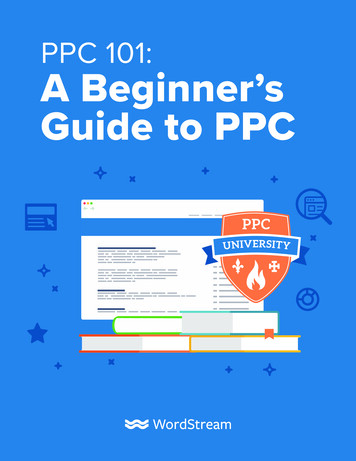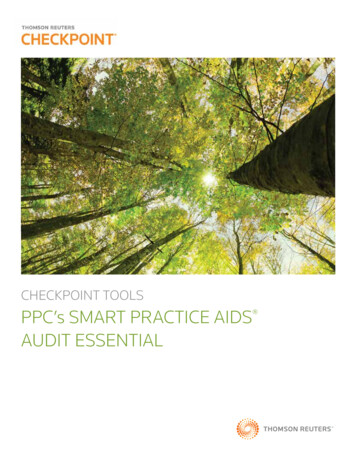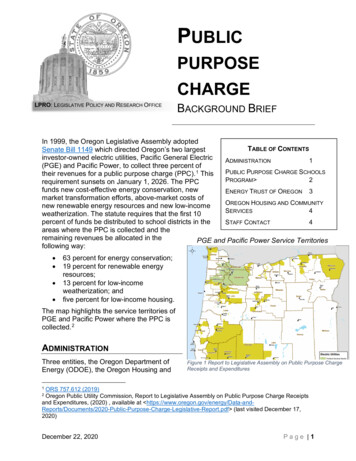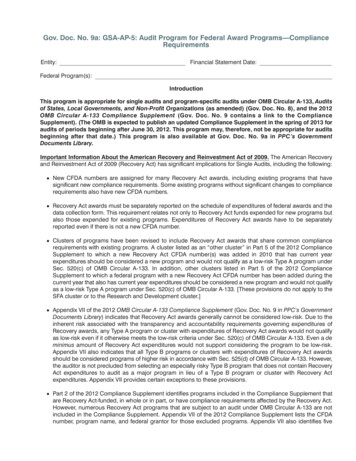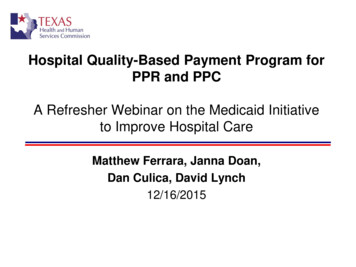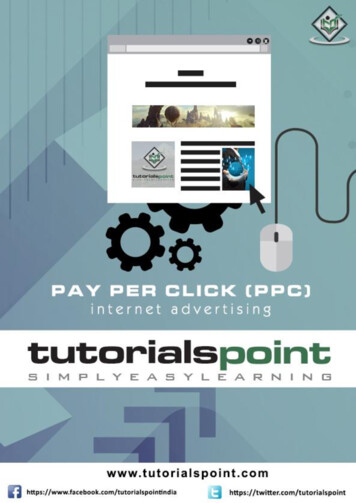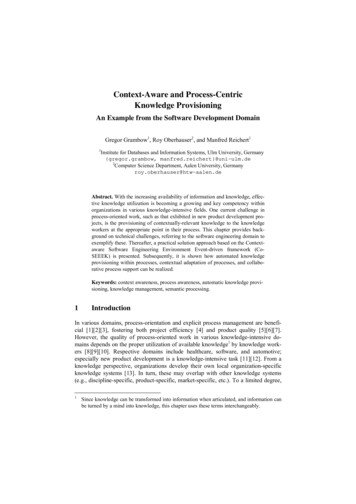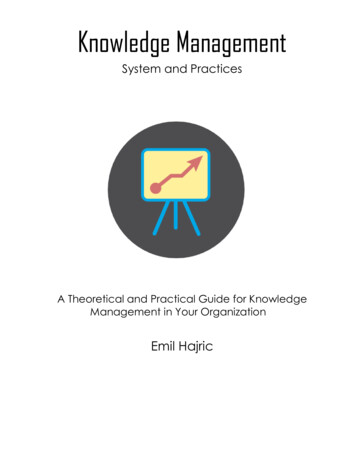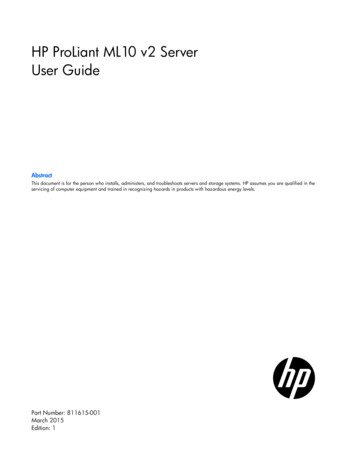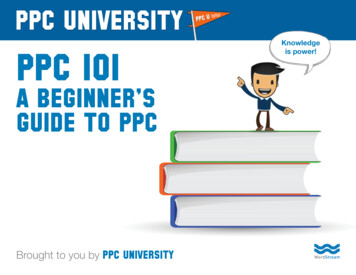
Transcription
PPC 101A BEGINNER’SGUIDE TO PPCBrought to you by PPC UNIVERSITYKnowledgeis power!
Lesson Plan: PPC 101TableoConte fntsWhat Is PPC?. 3Terms to Known Click-Through Rate (CTR).10n Quality Score.15n Cost Per Click.20n Cost Per Action (CPA).25n Conversion Rate Optimization (CRO). 29n Keywords. 35n Ad Groups. 42n Text Ads. 45How to Set Up an AdWords Account.50 2014, WordStream Inc. All rights reserved. WordStream technologies are protected by pending US patents.2
WHAT IS PPC?Whether you’ve heard a little about PPC marketing and arecurious to learn more, or you already know that you want touse PPC to market your business, but aren’t sure where tostart, you’ve come to the right place!This is the first lesson in PPC University, a set of threeguided courses that will teach you everything you need toknow about PPC and how to make it work for you.First, we’ll need to define PPC and establish a basicunderstanding of how PPC advertising works. 2014, WordStream Inc. All rights reserved. WordStream technologies are protected by pending US patents.3
What Is PPC?PPC stands for pay-per-click, a model of internet marketing in which advertisers pay afee each time one of their ads is clicked. Essentially, it’s a way of buying visits to your site,rather than attempting to “earn” those visits organically.Search engine advertising is one of the most popular forms of PPC. It allows advertisersto bid for ad placement in a search engine’s sponsored links when someone searches ona keyword that is related to their business offering. For example, if we bid on the keyword“PPC software,” our ad might show up in the very top spot on the Google results page.Every time our ad is clicked, sending a visitor to our website, we have to pay the searchengine a small fee. When PPC is working correctly, the fee is trivial, because the visit isworth more than what you pay for it. In other words, if we pay 3 for a click, but the clickresults in a 300 sale, then we’ve made a hefty profit.A lot goes into building a winning PPCcampaign: from researching and selectingthe right keywords, to organizing thosekeywords into well-organized campaignsand ad groups, to setting up PPC landingpages that are optimized for conversions.Search engines reward advertisers whocan create relevant, intelligently targetedpay-per-click campaigns by chargingthem less for ad clicks. If your ads andlanding pages are useful and satisfying to users, Google charges you less per click, leadingto higher profits for your business. So if you want to start using PPC, it’s important to learnhow to do it right. 2014, WordStream Inc. All rights reserved. WordStream technologies are protected by pending US patents.4
What Is Google AdWords?Google AdWords is the single most popular PPC advertising system in the world.The AdWords platform enables businesses to create ads that appear on Google’s searchengine and other Google properties.AdWords operates on a pay-per-click model, inwhich users bid on keywords and pay for eachclick on their advertisements. Every time asearch is initiated, Google digs into the poolof AdWords advertisers and chooses a set ofwinners to appear in the valuable ad space onits search results page. The “winners” arechosen based on a combination of factors,including the quality and relevance of theirkeywords and ad campaigns, as well as thesize of their keyword bids.More specifically, who gets to appear on thepage is based on and advertiser’s Ad Rank,a metric calculated by multiplying two keyfactors — CPC Bid (the highest amount an advertiser is willing to spend) and Quality Score(a value that takes into account your click-through rate, relevance, and landing pagequality). This system allows winning advertisers to reach potential customers at a cost thatfits their budget. It’s essentially a kind of auction. The below infographic illustrates how thisauction system works. 2014, WordStream Inc. All rights reserved. WordStream technologies are protected by pending US patents.5
How Does the AdWords Auction Work?Conducting PPC marketing through AdWords is particularlyvaluable because, as the most popular search engine, Googlegets massive amounts of traffic and therefore delivers the mostimpressions and clicks to your ads. How often your PPC ads appeardepends on which keywords and match types you select.While a number of factors determine how successful your PPCadvertising campaignwill be, you can achieve a lot by focusing on:n Keyword Relevance: Crafting relevant PPC – keyword lists,tight keyword groups, and proper ad text.nLanding Page Quality: Creatingoptimized landing pages with persuasive,relevant content and a clear call-to-action,tailored to specific search queries.nQuality Score: Quality Score isGoogle’s rating of the quality andrelevance of your keywords, landingpages, and PPC campaigns.Advertisers with better Quality Scoresget more ad clicks at lower costs.Got it? 2014, WordStream Inc. All rights reserved. WordStream technologies are protected by pending US patents.6
PPC Keyword ResearchKeyword research for PPC can be incredibly time-consuming,but it is also incredibly important. Your entire PPC campaign is builtaround keywords, and the most successful AdWords advertiserscontinuously grow and refine their PPC keyword list. If you only dokeyword research once, when you create your first campaign, youare probably missing out on hundreds of thousands of valuable,long-tail, low-cost and highly relevant keywords that could be drivingtraffic to your site.An effective PPC keyword list should be:nRelevant: Of course, you don’t want to be paying forWeb traffic that has nothing to do with your business. Youwant to find targeted keywords that will lead to a higher PPCclick-through rate, effective cost per click, and increasedprofits. That means the keywords you bid on should beclosely related to the offerings you sell.nExhaustive: Your keyword research should include not onlythe most popular and frequently searched terms in your niche,but also to the long tail of search. Long-tail keywords are morespecific and less common, but they add up to account for themajority of search-driven traffic. In addition, they are lesscompetitive, and therefore less expensive. 2014, WordStream Inc. All rights reserved. WordStream technologies are protected by pending US patents.7
n Expansive: PPC is iterative. You want to constantly refineand expand your campaigns, and create an environmentin which your keyword list is constantly growing and adapting. 2014, WordStream Inc. All rights reserved. WordStream technologies are protected by pending US patents.8
Managing Your PPC CampaignsOnce you’ve created your new campaigns, you’ll need to manage them regularly tomake sure they continue to be effective. In fact, regular account activity is one of the bestpredictors of account success. You should be continuously analyzing the performance ofyour account and making the following adjustments to optimize your campaigns:You’ll learn more about all of theseelements of PPC campaign managementas you move forward through thecoursework in PPC University.n Add PPC Keywords: Expand the reach of your PPC campaigns by addingkeywords that are relevant to your business.If you’re ready to get started with PPC,skip ahead to learn how to set up anAdWords account.n Add Negative Keywords: Add non-converting terms as negative keywords toimprove campaign relevancy and reduce wasted spend.n Split Ad Groups: Improve click-through rate (CTR) and Quality Score by splittingup your ad groups into smaller, more relevant ad groups, which help you createmore targeted ad text and landing pages.n Review Costly PPC Keywords: under-performing keywords and shut them offif necessary.If you’ve already got an AdWordsaccount, we suggest you use our FREEAdWords Performance Grader to helpyou zero in on areas of improvement.In 60 seconds or less, you’ll receive acustomized report grading your accountperformance in 9 key areas, includingclick-through rate, Quality Score andaccount activity.n Refine Landing Pages: Modify the content and calls-to-action (CTAs) of yourlanding pages to align with individual search queries in order to boost conversionrates. Don’t send all your traffic to the same page. 2014, WordStream Inc. All rights reserved. WordStream technologies are protected by pending US patents.9
CLICK-THROUGH RATEAchieving a high click-through rate is essential to yourPPC success, because it directly affects both your QualityScore and how much you pay every time someone clicksyour search ad. Are your click-through rates holding youback, or are they high enough?Click-through rate (CTR) is a metric that measures thenumber of clicks advertisers receive on their ads per theirnumber of impressions. In this tutorial you’ll learn:Learn what constitutesa good click-throughrate for PPC, and howyou can get one.n Exactly how click-through rate is calculated.n Why click-through rate is important to yourpay-per-click marketing account.n Learn what constitutes a good click-through ratefor PPC, and how you can get one. 2014, WordStream Inc. All rights reserved. WordStream technologies are protected by pending US patents.10
So What Is Click-Through Rate, Anyway?As mentioned above, PPC click-through rate is the rate at which your PPC ads are clicked. This number is the percentageof people who view your ad (impressions) and then actually go on to click the ad (clicks). The formula for CTR looks like this:(Total Clicks on Ad) / (Total Impressions) Click Through RateGenerally, you can view your click-thru rate within the dashboard of your PPC account.Why Do Click-ThroughRates Matter?Click-through rate is important to your account because it directly affectsyour Quality Score. Google AdWords and other search marketing platforms offerpricing discounts for ads that offer high relevance (read: make searchers happy).One means for doing this is to offer higher Quality Scores to ads with highAdWords click-through rates:n High click-through rates lead to high Quality Scores.n High Quality Scores allow you to improve or maintain ad position forlower costs.Additionally, if you are advertising on relevant queries, achieving a high click-throughrate means that you are driving the highest possible number of people to youroffering. 2014, WordStream Inc. All rights reserved. WordStream technologies are protected by pending US patents.11
What’s A “Good” Click-Through Rate?This is a hotly debated topic: what constitutes a good click-through rate?From a purely statistical standpoint, it depends. Take a look at Yahoo’s answer to the“what’s a good click-through rate” question:The honest answer to the question is, “It depends.” Click-through rates arenaturally going to vary from campaign to campaign, and even from keywordto keyword. Everything involved in the way your ad is displayed plays a part,from your ad copy to the ad’s ranking on the results page.So while you want to have a “high” click-through rate, there’s really no magic number.Average click-through rate will vary by industry, and your expected CTR depends on yourad’s position, among other factors. Generally speaking, as we mentioned above, you wantas high a click-through rate as possible.Except when you don’t. 2014, WordStream Inc. All rights reserved. WordStream technologies are protected by pending US patents.12
When Higher Click-Through RatesAre Actually Bad For BusinessA high CTRis not alwaysa good thing.If a keyword isn’t pertinent to your business or isn’t going to generate sales, leads,branding gains, etc. then a high click-through rate for that term is actually bad forbusiness. The reasoning for this is fairly clear:n You’re paying for every click.n A lot of clicks generate a lot of ad spend.n Some times you’re generating clicks on keywords that are priced too high, andwon’t turn a profit even if they convert.n Irrelevant terms and clicks are just spending money without bringing in additionalbusiness.So you don’t always want higher click-through rates: what you want are high CTRs onkeywords that are:n Relevant — Have to do with your ad text, your landing page, and your offering.n Affordable — Keywords that aren’t going to be profit-prohibitive.So, in a nutshell, a good CTR means first targeting the right words, then getting as manypeople as you can to click on those ads. 2014, WordStream Inc. All rights reserved. WordStream technologies are protected by pending US patents.13
Achieving Strong Click-ThroughRates for Your AdsAchieving strong click-through rates in PPC,then, depends on:n Targeted keywords to bid on.n Cost-efficient clicks.n Tools and methodology for closelyintegrating keywords with ad textand landing pages.n The ability to quickly and efficientlysegment keyword groups to generatecloser targeting.Remember, the higher your click-through rate,the better your Quality Scores will likely be, andhigh Quality Scores are one of the single bestpredictors of success in PPC. 2014, WordStream Inc. All rights reserved. WordStream technologies are protected by pending US patents.14
QUALITY SCOREIf you’re trying to master PPC, you need a solidunderstanding of Quality Score. That’s because yourQuality Scores have enormous influence over the costand effectiveness of your paid search campaigns.Just as your credit score can affect whether or notyou qualify for a loan and how high your interest rateis, Google Quality Score affects how your PPC adsperform and how much you pay for each click.Your Quality Scoreshave enormousinfluence over thecost and effectivenessof your paid searchcampaigns. 2014, WordStream Inc. All rights reserved. WordStream technologies are protected by pending US patents.15
What Is Quality Score?Quality Score is Google’s rating of the quality and relevance of both your keywordsand PPC ads. It is used to determine your cost per click (CPC) and multiplied by yourmaximum bid to determine your ad rank in the ad auction process. Your Quality Scoredepends on multiple factors, including:n Your click-through rate (CTR)n The relevance of each keyword toits ad groupn Landing page quality and relevancen The relevance of your ad textn Your historical AdWords accountperformanceNo one outside of Google knows exactly how much each factor “weighs” in the QualityScore algorithm, but we do know that click-through rate is themost important component.When more people who see your ad click it, that’s a strong indication to Google that yourads are relevant and helpful to users. Accordingly, Google rewards you with:n Higher ad rankingsn Lower costs 2014, WordStream Inc. All rights reserved. WordStream technologies are protected by pending US patents.16
Benefits of Improving Google Quality ScoreBy analyzing thousands of PPC accounts, we know that Quality Score has a directcorrelation on your PPC success. By optimizing your Quality Scores, you’ll be settingyourself up for higher return on investment (ROI). That’s because higher Quality Scorescorrelate with lower cost per conversion! Cost per conversion is different from cost perclick. It’s not how much you pay for each click, but how much you pay when someonetakes the action you want them to take, whether that’s signing up for a free trial or makinga product purchase. Since not every click results in a conversion, cost per conversion isgenerally higher than cost per click.Luckily, strong Quality Scores lower both your cost per click and your cost per conversion.Generally speaking, the higher yourQuality Score, the lower your cost perconversion. Remember, a high QualityScore is Google’s way of saying that yourPPC ad meets your potential customers’needs. The better you are at meeting theprospect’s needs, the less Google willcharge you for the ad click.The higher yourQuality Score, thelower your costper conversion. 2014, WordStream Inc. All rights reserved. WordStream technologies are protected by pending US patents.17
How Do You Increase Your Quality Score?Since Quality Score determines where and how often your ads appear, it’simportant to boost your ratings by working consistently on your account. This can beachieved by focusing your efforts on several key areas:n Keyword Research — Discover new, highly relevant keywords to add to yourcampaigns, including long-tail opportunities that can contribute to the bulk of youroverall traffic.Boost yourratings withthese tips!n Keyword Organization — Split your keywords into tight, organized groups thatcan be more effectively tied to individual ad campaigns.n Refining Ad Text — Test out PPC ad copy that is more targeted to your individualad groups. More effective ads get higher CTR, one of the best ways to improveQuality Score.n Optimizing Landing Pages — Follow landing page best practices to createpages that connect directly with your ad groups and providea cohesive experiencefor visitors, from keyword to conversion.n Adding Negative Keywords — Continuously research, identify, and excludeirrelevant search terms that are wasting your budget. 2014, WordStream Inc. All rights reserved. WordStream technologies are protected by pending US patents.18
u Check out ourlibrary of PPCwhite papers!As you can see, Quality Score is primarily a measure of relevance, and improving keywordQuality Score is a matter of structuring your PPC campaigns into small, well-organized,tightly knit groups of keywords. Better keyword research and organization will also naturallyimprove the quality and specificity of your ads and website content, allowing you to targetthe exact audience most likely to be searching for your offerings.Low AdWords Quality Scores are primarily the result of disconnect between keywords, adgroups, ad text, and landing page content. A high Quality Score comes naturally when anAdWords account contains organized keywords in appropriate keyword groups, ad textthat corresponds with certain ad groups, and landing pages that connect with the ad text’soffer. While there is no easy, foolproof answer to improving your Quality Score formula,paying careful attention to relevance will greatly improve your scores.More Quality Score ResourcesWant to learn more about how Quality Score works and how to increase your ratings? Check out the following resources:n Quality Score Toolkit — This free toolkit is a Quality Score 101 course all wrapped up in one package. The toolkit includes our“Mastering Quality Score” video, our Quality Score white paper, and a Quality Score Cheat Sheet for quick and easy reference.n Improving Quality Score: The Value of Being More Relevant — This free white paper takes an in-depth look at how QualityScore is calculated and lays out a strategy for increasing your Quality Scores.n Understanding and Improving Quality Score — Learn how to improve Quality Scores with this free webinar that helps youunderstand why you should pay close attention to your quality score. Larry Kim, Founder of WordStream clears up mysteriessurrounding the elusive Quality Score. 2014, WordStream Inc. All rights reserved. WordStream technologies are protected by pending US patents.19
COST PER CLICKCost Per Click (CPC) refers to the actual price you pay foreach click in your pay-per-click (PPC) marketing campaigns.In this lesson you’ll learn:n A more thorough definition of cost per click.n Why CPC is important to you and your PPCcampaigns.Learn how tolower your costper click.n How to lower your cost per click while maintaining(or even improving) traffic and conversion levels. 2014, WordStream Inc. All rights reserved. WordStream technologies are protected by pending US patents.20
What Is CPC?A “click” on one of your PPC text ads represents a visit, or an interaction with yourcompany’s product or service offering. Every click in a PPC campaign represents attentionfrom a person who is searching for something that you offer. This attention is what you’rebuying, as an advertiser, so it’s important to note two factors:n What type of attention you’re going after, andn How much you’re paying for it.How Is Cost Per Click Calculated?The actual formula for cost per click in AdWords is:CPC isinfluenced byQuality Score.As an advertiser, your cost per click will always be less than or equal to your maximum bid,as it is an average of bids against a series of competitors over a period of time. Becauseof how Google’s Adwords Auction works, your actual cost per click is heavily influenced byboth you and your closest competitor’s ad rank, maximum bid, and Quality Score. 2014, WordStream Inc. All rights reserved. WordStream technologies are protected by pending US patents.21
The Importance of Cost Per Clickin Search AdvertisingCost-per click is important because it is the number that is going to determine thefinancial success of your paid search campaigns.Your return on investment, whether you’re over- or underpaying for each action, will bedetermined by how much you are paying for clicks, and by what kind of quality you aregetting for that investment. Since the overall ROI of your campaignsis determined by how much you’re payingfor clicks and the quality of traffic they’rebringing in, it is important to think aboutcost per click in terms of both cost andvalue. You want to identify and targetclicks that are both inexpensive andvaluable. 2014, WordStream Inc. All rights reserved. WordStream technologies are protected by pending US patents.22
Lowering CPC While Maintaining ValueSo how do you go about lowering the price you’repaying for each click, while sustaining (or even improvingupon) the value of your visits? Two key paths of actioncome into play here:Raise Your Quality ScoreGoogle has created an automated system that offers pricingdiscounts to well-managed PPC campaigns with highQuality Scores. Currently, accounts with quality scoresof 6 or higher (the average score today is 5) are granteda 16–50% decrease in CPC, whereas accounts with a 4 or lower Quality Score see a25–400% increase in CPC!Quality Scoresof 6 or higher aregranted a 16–50%decrease in CPC.Boost your chances of a drastically discounted cost per click by adhering to Quality Scorebest practices:n Increase click-through rates (CTR) by creating compelling, relevant ads.n Build out closely related ad groups.n Optimize ad text and landing pages that speak to individual search intent.Expand Your ReachBy discovering new, relevant and valuable clicks, the distribution of your budget willbe improved substantially. To do this, you’ll have to find new PPC keywords and searchadvertising opportunities. But you can’t just expand without also paring back — you needto simultaneously eliminate irrelevant or overpriced clicks from your campaigns. 2014, WordStream Inc. All rights reserved. WordStream technologies are protected by pending US patents.23
Refine Your ReachContinually designating negative keywords in your AdWords account helps to control yourCPC by filtering out traffic from searchers that are highly unlikely to convert. So as you addnew keywords to your AdWords account, be sure to eliminate the losers. When you targetonly keywords that perform well and are relevant to your business, it ensures that:n Your spend is protected — Lowering your cost per click isn’t useful if you’repaying low prices for irrelevant clicks. Negative keywords tell your PPC campaignswhich terms not to target, therefore reserving your budget for relevant terms only.nYour Quality Score improves — If your keywords are clearly related to your adtext, landing pages, and offering, your click-through rate and other Quality Scorefactors will be positively affected. This gets you more cost-efficient clicks(remember, up to a 50% decrease in CPC!), and on search terms that are morelikely to convert.A low cost per click is key to PPC success because it ultimately translates into your costper conversion. You’ll learn more about that in the next lesson. 2014, WordStream Inc. All rights reserved. WordStream technologies are protected by pending US patents.24
COST PER ACTIONCost per action, or CPA — sometimes referred to as costper acquisition — is a metric that measures how much yourbusiness pays in order to attain a conversion.Generally, your CPA will be higher than your cost per click,or CPC, because not everyone who clicks your ad will goon to complete your desired action, whether it’s making apurchase or filling out a form to become a lead.Improving yourconversion rate willlower your CPA.Cost per action takes into account the number of ad clicksyou need before someone converts — in order words,improving your conversion rate will lower your CPA. 2014, WordStream Inc. All rights reserved. WordStream technologies are protected by pending US patents.25
How to Lower Your CPA in AdWordsWhat is Google’sall-importantmetric?Quality Score.So, what determines your CPA? Like most things PPC, your CPA is directly affectedby your Quality Score, Google’s all-important metric based on the quality of your keywords,ads, and landing pages. In general, the higher your Quality Score, the lower your costs —in fact, for each point your score is above the average Quality Score of 5, your CPA willdrop about 16%.Keeping your Quality Score high and your CPA low can be a huge benefit to your PPCbudget over time, giving you the opportunity to buy more exposure in the online advertisingspace and optimize the number of conversions that come from your ad spend. 2014, WordStream Inc. All rights reserved. WordStream technologies are protected by pending US patents.26
How Quality Score Affects Cost Per ActionIt’s well known that AdWords Quality Score affects your cost per click, but noteveryone realizes that Quality Score is every bit as important in determining your cost perconversion.When you plot average CPA against impression-weighted Quality Score, you see a strongcorrelation: The higher the Quality Score, the lower the cost per action. In other words,optimizing for Quality Score and optimizing for CPA are essentially the same thing.The table on the right shows how muchyou’ll save on cost per action if yourQuality Score is higher than 5. Likewise,having a below average Quality Scorewill increase your CPA, relative to yourcompetitors, which hurts your overall ROI. 2014, WordStream Inc. All rights reserved. WordStream technologies are protected by pending US patents.27
What Is Cost Per Action Bidding?CPA bidding is a method of paid advertising that allows you to tightly control youradvertising spend. Rather than paying Google for every time someone clicks on one ofyour ads (as with CPC bidding), CPA bidding only requires you to pay for each conversion,a metric you define yourself when you set up each campaign. This action might be a sale,a lead, a download, or some other conversion you define. CPA advertising can help youavoid spending money on search terms that may not be directly driving business. If oneof your ads displays in a SERP and does not match up with the searcher’s intent, you’llonly pay if the searcher engages with the ad and ultimately converts. 2014, WordStream Inc. All rights reserved. WordStream technologies are protected by pending US patents.28
CONVERSION RATE OPTIMIZATIONConversion rate optimization (CRO) is the process ofoptimizing your sponsored search ads, landing pages,and overall website design to raise your conversion rate.In other words, the goal is for the highest possiblepercentage of visitors to your site to convert, or completeyour desired action.CRO is quickly gaining in popularity because it’s seen asa way to increase profits from sales without raising youradvertising spend.The goal is for thehighest possiblepercentage of visitorsto your site to convert,or complete yourdesired action. 2014, WordStream Inc. All rights reserved. WordStream technologies are protected by pending US patents.29
How to Optimize Conversion Rates for PPCn Timen Resourcesn TestingOf course, just as SEO isn’t really free, neither is a website redesign. It requires timeand resources and, if you’re doing it right, testing. Nonetheless, it’s more than worth yourwhile to familiarize yourself with the basic principles of website conversion optimization,so you can maximize the chances that a potential customer who arrives at your site froma search engine becomes a qualified lead or a paying customer.There are a number of things you can do to increase your conversion rate, among them:nWrite compelling, clickable PPC ads that are highly relevant to the keyword/search query and your intended audience. All the better if you’re targeting highintent mid-tail and long-tail keywords that indicate a searcher who is late in thebuying cycle, as those consumers are more likely to convert.nMaintain a high degree of relevance between your ads and correspondinglanding pages. Your landing page should deliver on the promise of your ad (thecall to action) and make it easy for the searcher to complete that action, be itsigning up for a newsletter, downloading a white paper or making a purchase.n Test your landing page design. Conduct A/B testing to find the right layout, copy,and colors that push the highest percentage of site visitors to fill out your form, callin, or otherwise convert to a valuable lead or customer. 2014, WordStream Inc. All rights reserved. WordStream technologies are protected by pending US patents.30
Optimizing PPC Conversions:Start with the Right KeywordsWhen you start thinking about conversion rate optimization, it’s tempting to fiddlearound with buttons and forms and other low-in-the-funnel design elements that mightmake or break the sale. But rememb
What Is Google AdWords? Google AdWords is the single most popular PPC advertising system in the world. The AdWords platform enables businesses to create ads that appear on Google’s search engine and other Google properties. AdWords operates on a pay-per-click model, in which users bid on
